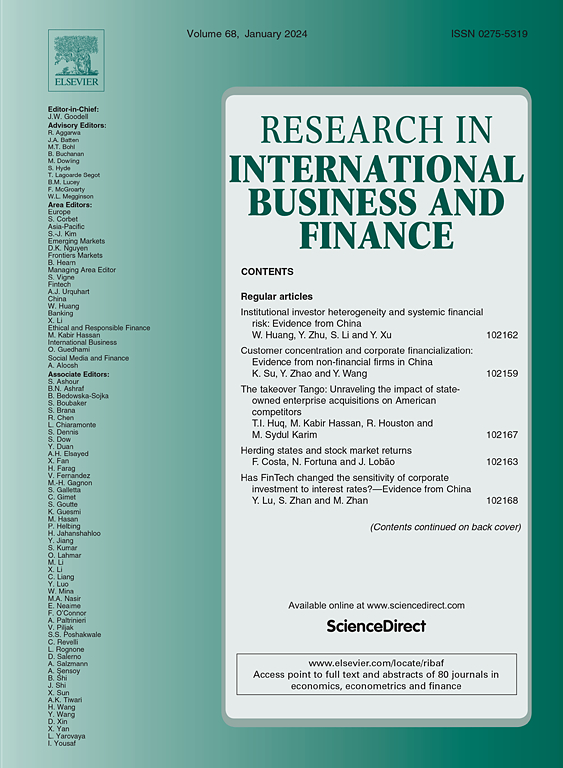预测金融周期与动态集成选择框架使用领先,一致和滞后指标
IF 6.9
2区 经济学
Q1 BUSINESS, FINANCE
Research in International Business and Finance
Pub Date : 2025-08-01
DOI:10.1016/j.ribaf.2025.103114
引用次数: 0
摘要
本文建立了一个预测印度金融周期的模型,并定义了领先、同步和滞后指标,以实现研究目标。因变量为二值,并使用合成少数过采样技术(SMOTE)来校正数据集中的不平衡。该研究利用了六种不同的动态集成选择(DES)模型和五种不同的分类器池。可解释人工智能(XAI)用于识别特征的重要性。将预测框架应用于具有不同特征的不同时间段,所有的DES框架都能产生有效的预测。然而,各阶段指标的重要性和作用各不相同。我们的研究结果表明,虽然在周期阶段,汇率波动在解释金融周期方面发挥了重要作用,但在向上扩张阶段,银行信贷扩张、资本形成和房地产增长是重要因素。在下行阶段和看跌环境中,波动率指数和油价显得尤为重要。本文章由计算机程序翻译,如有差异,请以英文原文为准。
Predicting financial cycles with dynamic ensemble selection frameworks using leading, coincident and lagging indicators
This paper develops a model for predicting financial cycles in India, and defines leading, coincident, and lagging indicators to achieve the research objective. The dependent variable is binary, and Synthetic Minority Oversampling Technique (SMOTE) is used for correcting imbalances in the dataset. The study utilizes six distinct Dynamic Ensemble Selection (DES) models, and five different pools of classifiers. Explainable Artificial Intelligence (XAI) is used to identify feature importance. The predictive framework is applied to different time periods with distinct characteristics, and all the DES frameworks yield efficient forecasts. The importance and role of the indicators, however, differ among phases. Our results show, that while during CYCLE phases, exchange rate fluctuations play a significant role in explaining financial cycles, in an UPWARD expansionary phase, expansion in bank credit, capital formation, and realty growth are significant factors. During a DOWNWARD phase and a bearish environment, VIX and oil prices emerge significant.
求助全文
通过发布文献求助,成功后即可免费获取论文全文。
去求助
来源期刊

Research in International Business and Finance
BUSINESS, FINANCE-
CiteScore
11.20
自引率
9.20%
发文量
240
期刊介绍:
Research in International Business and Finance (RIBAF) seeks to consolidate its position as a premier scholarly vehicle of academic finance. The Journal publishes high quality, insightful, well-written papers that explore current and new issues in international finance. Papers that foster dialogue, innovation, and intellectual risk-taking in financial studies; as well as shed light on the interaction between finance and broader societal concerns are particularly appreciated. The Journal welcomes submissions that seek to expand the boundaries of academic finance and otherwise challenge the discipline. Papers studying finance using a variety of methodologies; as well as interdisciplinary studies will be considered for publication. Papers that examine topical issues using extensive international data sets are welcome. Single-country studies can also be considered for publication provided that they develop novel methodological and theoretical approaches or fall within the Journal''s priority themes. It is especially important that single-country studies communicate to the reader why the particular chosen country is especially relevant to the issue being investigated. [...] The scope of topics that are most interesting to RIBAF readers include the following: -Financial markets and institutions -Financial practices and sustainability -The impact of national culture on finance -The impact of formal and informal institutions on finance -Privatizations, public financing, and nonprofit issues in finance -Interdisciplinary financial studies -Finance and international development -International financial crises and regulation -Financialization studies -International financial integration and architecture -Behavioral aspects in finance -Consumer finance -Methodologies and conceptualization issues related to finance
 求助内容:
求助内容: 应助结果提醒方式:
应助结果提醒方式:


